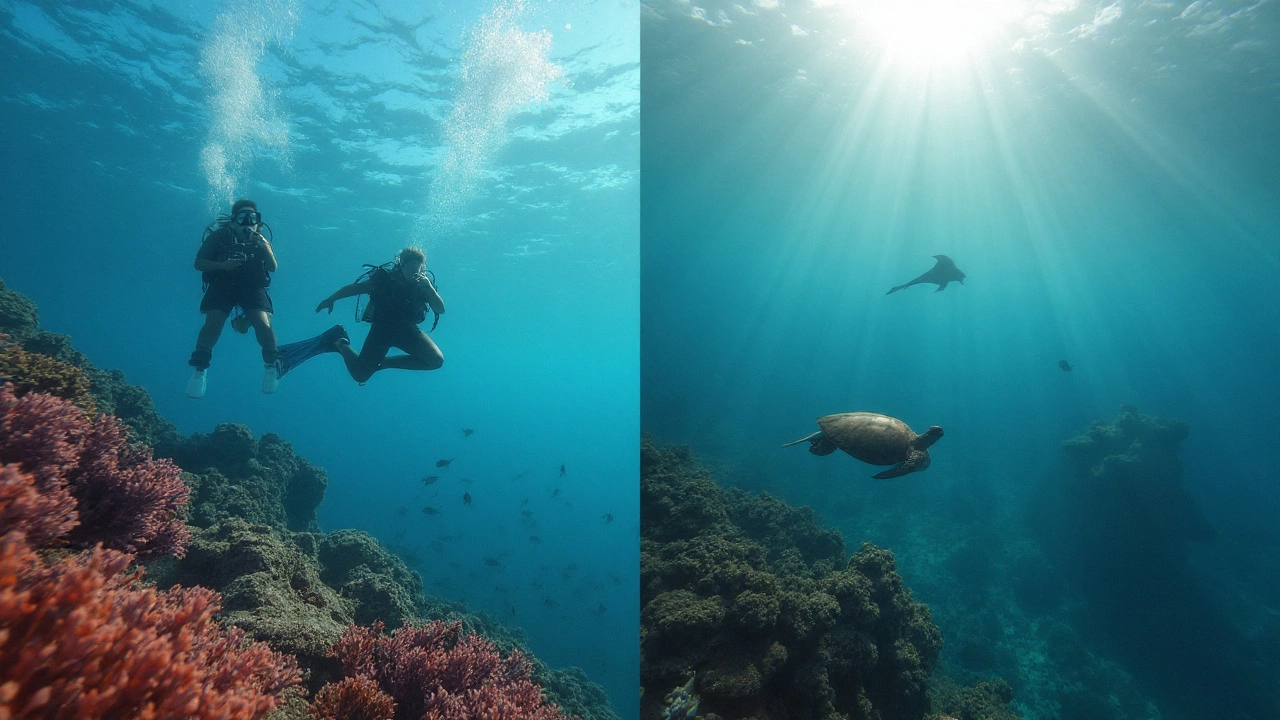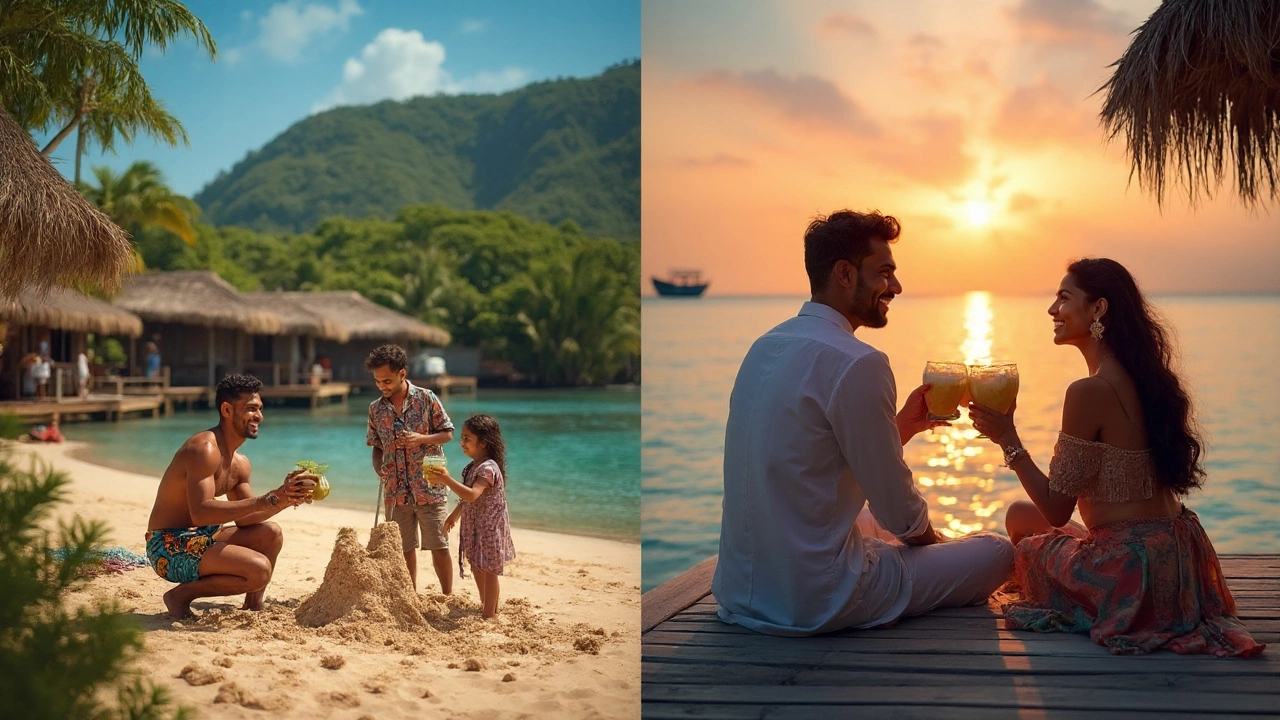Fiji vs Maldives: Which Is Nicer? A Practical 2025 Comparison for Island Lovers

- Sep, 22 2025
- 0 Comments
- Aaron Blackwood
You’re choosing between two postcard dreams and you want the honest answer: which is nicer, Fiji or Maldives? The truth: “nicer” depends on whether you crave human warmth and varied landscapes (Fiji) or hyper-clear lagoons and private-island polish (Maldives). This guide cuts through the brochure gloss with real travel times, costs, weather, diving, and what the day-to-day actually feels like.
TL;DR
- If you want culture, variety, kid-friendly resorts, and easier flights from New Zealand or Australia, pick Fiji.
- If you want outrageous water clarity, overwater villas, and a castaway vibe on private islands, pick the Maldives.
- Budgets: Fiji mid-range stays often US$200-400/night; Maldives water villas typically US$600-2,000+/night (guesthouses from ~US$60).
- Best months: Fiji (May-Oct dry); Maldives (Nov-Apr dry). Rainier periods can still be great for deals and mantas.
- Diving/snorkeling: Fiji = soft corals and sharks; Maldives = lagoon clarity, manta trains, whale sharks.
What “nicer” really means: define your win
“Nicer” gets real when you break it into six parts: water quality, beaches, culture, costs, weather, and ease of getting there. Each destination wins different rounds. That’s your shortcut.
Meet the destinations (with clear definitions)
Fiji is an archipelago of around 330 islands in the South Pacific, known for lush volcanic landscapes, soft coral reefs, and a strong Melanesian-Polynesian culture centered on community and kava ceremonies.
Maldives is an Indian Ocean nation of 26 natural atolls and 1,000+ coral islands, famous for overwater bungalows, glassy lagoons, and one-island-one-resort seclusion.
South Pacific Ocean is the oceanic region where Fiji sits, influencing its trade winds, swell (great for surfing), and tropical marine ecosystems.
Indian Ocean is the warm-water basin surrounding the Maldives, driving its monsoon seasons, nutrient flows, and pelagic megafauna such as whale sharks.
Yasawa Islands are a string of dry, sun-soaked islands in northwest Fiji with sandy beaches, blue lagoons, and budget-to-boutique stays linked by the Yasawa Flyer catamaran.
Baa Atoll is a UNESCO Biosphere Reserve in the Maldives noted for Hanifaru Bay’s seasonal manta ray aggregations (typically June-October).
Nadi International Airport is the primary gateway to Fiji on Viti Levu, linking visitors to the Mamanuca and Yasawa islands by boat or small plane.
Velana International Airport is the main international airport for the Maldives near Malé, feeding seaplane and speedboat transfers to resort islands.
Travel time and transfers: how long will it actually take?
From New Zealand and Australia, Fiji is the quicker hop. Direct flights from Auckland to Nadi often run ~3 to 3.5 hours. From Sydney or Brisbane, it’s around 3.5 to 4 hours. Maldives is a long-haul from this side of the world, usually 17-22 hours with stops via hubs like Singapore or Dubai.
Logistics shape your first and last day. In Fiji, many travelers land at Nadi International Airport, overnight near Denarau, and ferry or fly to islands the next morning. Transfers are straightforward and priced more gently. In Maldives, transfers from Velana International Airport are fast but pricey: seaplanes often cost US$250-600 per person round-trip; speedboats are cheaper but depend on the distance to the resort.
Decision rule: If you hate long flights and want to be on a beach by afternoon, Fiji wins. If you can tolerate a long-haul for that surreal lagoon clarity, Maldives pays off.
Costs and value: where your money goes further
Money feels different in each place. Fiji uses the Fiji Dollar (FJD); the Maldives uses the Maldivian Rufiyaa (MVR), though USD is widely accepted in resorts.
- Fiji: Mid-range resorts typically US$200-400/night; upscale US$500-900; high-end US$1,000-2,000+. Meals are often à la carte or meal plans (~US$60-120/day per adult, depending on property). Inter-island ferries are affordable; domestic flights cost more but are reasonable.
- Maldives: Guesthouses on local islands can be US$60-150/night. Resort beach villas often start around US$300-600 in low season and climb well above US$1,000 in peak. Overwater villas commonly run US$600-2,000+ per night. Many resorts bundle half-board/full-board or all-inclusive plans; factor service charges and green taxes.
Heuristic: If your dream is an overwater villa without a five-figure bill, Fiji has a few options but they’re rare. The Maldives invented that category and does it best, but it will strain the budget unless you hunt shoulder-season deals or choose a guesthouse plus day trips to resorts.
Water, beaches, and marine life: what you see when you mask up
Maldives wins water clarity by a nose. Its reef-ringed lagoons can feel like a private aquarium with 20-40 meters of visibility on good days. That’s a big part of why honeymooners rave.
Fiji counters with color and drama. Jacques Cousteau dubbed it the “soft coral capital of the world” thanks to nutrient-rich currents that light up reefs in pinks and purples. Expect strong shark action at places like Beqa Lagoon; rainbow walls near Taveuni; and calm, family-friendly snorkeling in the Yasawa Islands and Mamanucas.
Signature encounters:
- Maldives: Manta rays sweep into Baa Atoll (Hanifaru Bay) in season; whale sharks cruise South Ari Atoll year-round. House reefs can be steps from your villa.
- Fiji: Soft corals at Rainbow Reef (Taveuni), shark dives at Beqa, and relaxed snorkel spots around the Blue Lagoon area in the Yasawas.
Beaches differ too. Maldives beaches are powdery and mostly white coral sand; lagoon entries are typically calm. Fiji’s sand varies from white to golden to volcanic black; some beaches are coral-fringed, so reef shoes help. If your ideal is swimming in a giant turquoise pool, Maldives feels “nicer.” If you prefer variety and wilder backdrops, Fiji takes it.
Culture, food, and vibe: the feel of the place
Fiji is social. Resorts plug into local villages, kava nights, and meke dance. You can wander markets in Nadi or Savusavu, hike to waterfalls, or hop a local bus. Food is a mix of Fijian (lovo earth-oven feasts, kokoda-coconut ceviche) and Indo-Fijian curries; portions are hearty and prices fair outside of top-end resorts.
Maldives is Zen. Most resorts sit alone on an island, tuned for privacy. Service is polished; days revolve around water and wellness. On local islands, Maldives is conservative (Islamic); dress modestly away from designated bikini beaches, and note that alcohol is not served on inhabited islands (it is available on resort islands and liveaboards). Malé is a quick cultural peek but crowded; most visitors dip in for a short tour and head back to the water.
If warmth-from-people matters, Fiji’s bula spirit is hard to beat. If peace-from-privacy matters, the Maldives’ one-island-one-resort setup wins.
Families, honeymoons, and friend trips: who fits where
- Families: Fiji shines with kids’ clubs, nanny services, and flexible dining. Beaches in the Mamanucas and Yasawas are great for beginners. Multi-room bures keep costs manageable.
- Honeymoons: Maldives is purpose-built-overwater bungalows, private dining on sandbanks, villa butlers. Fiji can do romance, especially at boutique adults-only islands, but the Maldives sets a different bar for privacy.
- Friends/surf trips: Fiji wins with surf like Cloudbreak and Restaurants (Tavarua/Namotu area), plus rafting the Upper Navua and hiking Taveuni’s Bouma Falls. Maldives has mellow reef breaks and smooth sailing liveaboards-great for cruisy longboard sessions.

Weather and best months
Fiji’s dry season runs roughly May-October with cooler nights; wet season November-April brings lush growth and the risk of tropical cyclones (peak risk usually Jan-Mar). The Maldives’ dry northeast monsoon is November-April; the wetter southwest monsoon is May-October, with more wind and passing squalls. Divers often prefer different seasons: Fiji’s winter can bring clearer water; Maldives’ wet season brings plankton that attracts mantas in places like Baa Atoll.
Booking tip: If you want the Maldives with fewer people and lower prices, target late April/early May or late October/early November. For Fiji, July-September is peak; shoulder months May/June and October are sweet spots.
Quick comparison table
| Attribute | Fiji | Maldives |
|---|---|---|
| Flight time from NZ/AU | ~3-4.5 hours (Auckland/Sydney to Nadi) | ~17-22 hours with connections |
| Transfers | Ferries, small planes; moderate costs | Seaplanes/speedboats; often expensive |
| Best for | Culture, families, surf, varied scenery | Honeymoons, water clarity, privacy |
| Typical nightly costs | US$200-900 mid/upscale; luxury 1,000+ | Guesthouses US$60-150; resorts 300-2,000+ |
| Diving highlights | Soft corals, sharks (Beqa), Rainbow Reef | Mantas (Baa), whale sharks (Ari), house reefs |
| Family friendliness | Excellent kids’ clubs and bures | Good in select resorts; many adult-focused |
| Culture access | High-villages, markets, festivals | Low on resorts; modest local-island tourism |
| Weather sweet spot | May-Oct | Nov-Apr |
So… which is nicer?
Use this simple rule: If “nicer” means jaw-drop water and private-island hush, it’s the Maldives. If “nicer” means richer days-meeting people, exploring different islands, surfing, hiking, and paying less for more space-Fiji takes it. For travelers from New Zealand and Australia, flight time and jet lag alone often tip the scales to Fiji for first-timers. For a big anniversary where the water itself is the star, Maldives is hard to beat.
By the way, search engines see both as valid for the query Fiji vs Maldives, but your best answer is personal: your time, budget, and what you want to feel when you wake up and look out at the water.
Sample 7-day budgets (realistic ranges)
- Fiji mid-range couple: Flights (ex-NZ) ~US$600-1,000 pp; 6 nights @ US$250 = US$1,500; meals/activities/transfers ~US$1,000. Ballpark total: US$3,100-3,800 for two.
- Maldives guesthouse couple: Flights (ex-NZ) US$1,200-1,600 pp; 6 nights @ US$100 = US$600; meals/transfers/activities ~US$1,000-1,400. Ballpark total: US$4,000-5,200 for two.
- Maldives overwater-villa couple: Flights US$1,200-1,600 pp; 6 nights @ US$900 = US$5,400; transfers ~US$500-1,000 for two; meals/activities ~US$1,500-2,000. Ballpark total: US$9,000-11,500 for two.
These are conservative, 2025-style ranges. Prices shift with seasons and promotions. Check resort inclusions (breakfast vs half-board vs all-inclusive) because Maldives dining can stack up fast.
Sustainability and reef health
Both countries are on the climate front line. The Maldives’ highest point is only a few meters above sea level; Fiji manages cyclone resilience and coastal protection. Coral bleaching events (notably 2016 and 2020) hit both regions. Many resorts now run coral nurseries and reduce single-use plastics; some add solar arrays and desalination. Ask about reef-safe sunscreen rules, marine biologist programs, and house reef health. UNESCO designations (like Baa Atoll) indicate stronger conservation frameworks.
Connected destinations you might compare next
- French Polynesia (Tahiti, Bora Bora): Closer to Fiji’s vibe but with iconic overwater bungalows.
- Cook Islands: Easy-going, accessible from NZ, great lagoons without the price of the Maldives.
- Seychelles and Mauritius: Indian Ocean alternatives with granite boulders (Seychelles) and more culture (Mauritius).
- Bali and the Gili Islands: Cheaper, lively, and surf-friendly, but more crowded.
Decision guide: fast pick
- Hate long flights? Choose Fiji.
- Dream of an overwater villa? Choose Maldives.
- Traveling with kids or a group? Choose Fiji.
- Prioritize snorkeling visibility above all else? Choose Maldives.
- Want culture, hikes, surf, and village life? Choose Fiji.
- Going for a once-in-a-decade romantic splurge? Choose Maldives.
Next steps and troubleshooting
- Pick your season: Dry months reduce weather risk; shoulder months save money. If mantas are a must, target Baa Atoll June-October.
- Lock transfers early: In the Maldives, match flight arrivals with seaplane schedules (they don’t run 24/7). In Fiji, check Yasawa Flyer or domestic flight times before booking hotels.
- Protect the budget: In the Maldives, pre-book meal plans; in Fiji, mix resort dining with local eateries where practical.
- Weather hiccups: Build buffer time. Seaplanes can pause for storms; Fiji ferries may delay in rough seas.
- Reef reality: Ask resorts for current reef status photos; choose sites with active restoration or healthy house reefs.

Frequently Asked Questions
Is Fiji or Maldives better for a honeymoon?
For sheer privacy and overwater villas, the Maldives leads. You’ll get glassy lagoons, private sandbank dinners, and butler service. Fiji also does romance-especially adults-only islands and boutique resorts-plus richer day trips (waterfalls, villages). If your dream photo is a villa on stilts over neon-blue water, pick Maldives. If you want variety with romance, Fiji works beautifully.
Which is cheaper: Fiji or Maldives?
Fiji is generally cheaper when you factor flights from NZ/AU and resort pricing. The Maldives can be affordable via guesthouses on local islands, but resort stays-especially overwater-add up, and transfers can cost hundreds per person. For mid-range holidays, Fiji delivers better value; for luxury lagoon stays, Maldives costs more but offers that signature experience.
When is the best time to visit Fiji and the Maldives?
Fiji’s sweet spot is May-October (drier, cooler). The Maldives’ prime months are November-April (drier, calmer seas). Shoulder seasons can be cheaper and still great. If manta rays are the goal, target Baa Atoll June-October; if surf is the goal, Fiji’s winter sees reliable South Pacific swell.
Is snorkeling better in Fiji or Maldives?
The Maldives wins on ease and clarity-many resorts have house reefs right off the beach with top visibility. Fiji’s snorkeling is excellent too, especially in the Yasawas and Taveuni areas, with more current-driven color and fish life. If you want aquarium-like calm, Maldives. If you want vivid soft corals and don’t mind a bit more movement, Fiji.
Are both destinations family-friendly?
Fiji is famously family-friendly-kids’ clubs, nannies, and wide beach areas. The Maldives has many family-friendly resorts and great shallow lagoons, but some properties skew adults-only or couples-focused. Look for kids’ clubs, splash zones, and family villas if choosing the Maldives with children.
Do I need a visa for Fiji or Maldives?
Many nationalities receive visa-free entry for Fiji for generous stays (often up to four months), while the Maldives commonly offers a 30-day visa on arrival. Always check your passport rules with official immigration sites before booking; policies can change.
How do transfers work in the Maldives compared to Fiji?
In Fiji, you’ll ferry or take a small plane to island groups like the Mamanucas and Yasawas-affordable and frequent. In the Maldives, transfers are by speedboat (for closer atolls) or seaplane (for farther resorts). Seaplanes are scenic but costly and run only in daylight; schedule flights to land early enough for same-day connections.
Which destination is safer or more reliable weather-wise?
Both are safe for tourists with normal precautions. Weather-wise, neither is guaranteed-tropics are tropics-but sticking to dry seasons boosts your odds. Fiji has tropical cyclone risk in wet months; the Maldives has monsoon swings with short squalls. Build buffer time, especially if a seaplane transfer is involved.
Can I combine both in one trip?
It’s possible but not efficient from NZ/AU due to distance. You’d route via Asia or the Middle East and spend a lot of time flying. If combining, make it a longer journey (2-3 weeks) and plan hub stopovers. Most travelers pick one per trip and compare another year with Tahiti, Cook Islands, or Seychelles.
Authoritative references used in building this guide include national tourism boards (Tourism Fiji; Maldives Marketing and PR Corporation), UNESCO listings for Baa Atoll, and widely reported climate and reef science summaries from NOAA and coral monitoring groups.